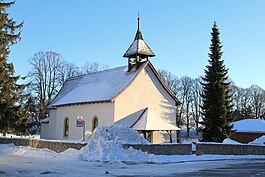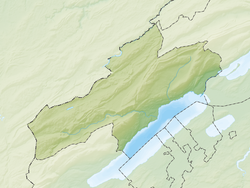Enges
Enges | |
|---|---|
 Chapel in Enges | |
| Coordinates: 47°4′N 7°1′E / 47.067°N 7.017°E | |
| Country | Switzerland |
| Canton | Neuchâtel |
| Area | |
| • Total | 9.59 km2 (3.70 sq mi) |
| Elevation | 816 m (2,677 ft) |
| Population (31 December 2018)[2] | |
| • Total | 272 |
| • Density | 28/km2 (73/sq mi) |
| Time zone | UTC+01:00 (Central European Time) |
| • Summer (DST) | UTC+02:00 (Central European Summer Time) |
| Postal code(s) | 2073 |
| SFOS number | 6453 |
| ISO 3166 code | CH-NE |
| Surrounded by | Cressier, Le Landeron, Lignières, Neuchâtel, Saint-Blaise, Savagnier, Villiers |
| Website | www SFSO statistics |
Enges is a
History
Enges is first mentioned in 1178 as en Enge. In 1212, it was mentioned as Einge.[3]
Geography
Enges has an area, as of 2009[update], of 9.6 square kilometers (3.7 sq mi). Of this area, 4.38 km2 (1.69 sq mi), or 45.7%, is used for agricultural purposes, while 4.95 km2 (1.91 sq mi), or 51.6%, is forested. Of the remaining land, 0.21 km2 (0.081 sq mi), or 2.2%, is settled (buildings or roads).[4]
Housing and buildings make up 0.8%, and transportation infrastructure make up 1.1%. Out of the forested land, 48.8% of the total land area is heavily forested and 2.8% is covered with orchards or small clusters of trees and the agricultural land, 15.3%, is used for growing crops while 23.4% is pastures and 6.9% is alpine pastures.[4]
The municipality consists of the hamlet of Lordel and three alpine seasonal settlements: Cressier, Enges and Grange Vallier.
It was part of the district of
Coat of arms
The blazon of the municipal coat of arms is Per fess, Or, a Grouse passant Sable, and Azure, a Gorge Argent with Pine-trees Vert.[6]
Demographics
Enges has a population (as of December 2020[update]) of 266.[7] As of 2008[update], 9.6% of the population are resident foreign nationals.[8] Over the last 10 years (2000–2010) the population has changed at a rate of -3.1%. It has changed at a rate of -7.6% due to migration and at a rate of 8.2% due to births and deaths.[9]
Most of the population (as of 2000[update]) speaks French (256 or 88.6%) as their first language, German is the second most common (25 or 8.7%) and English is the third (4 or 1.4%). There are 2 people who speak Italian.[10]
As of 2008[update], the population was 50.6% male and 49.4% female. The population was made up of 128 Swiss men (47.2% of the population) and 9 (3.3%) non-Swiss men. There were 122 Swiss women (45.0%) and 12 (4.4%) non-Swiss women.[11] Of the population in the municipality, 74 or about 25.6% were born in Enges and lived there in 2000. There were 98 or 33.9% who were born in the same canton, while 80 or 27.7% were born somewhere else in Switzerland, and 37 or 12.8% were born outside of Switzerland.[10]
As of 2000[update], children and teenagers (0–19 years old) make up 24.6% of the population, while adults (20–64 years old) make up 64.4% and seniors (over 64 years old) make up 11.1%.[9]
As of 2000[update], there were 108 people who were single and never married in the municipality. There were 154 married individuals, 7 widows or widowers and 20 individuals who are divorced.[10]
As of 2000[update], there were 110 private households in the municipality, and an average of 2.6 persons per household.[9] There were 21 households that consist of only one person and 11 households with five or more people. In 2000[update], a total of 109 apartments (86.5% of the total) were permanently occupied, while 9 apartments (7.1%) were seasonally occupied and 8 apartments (6.3%) were empty.[12] The vacancy rate for the municipality, in 2010[update], was 1.48%.[9]
The historical population is given in the following chart:[3][13]

Politics
In the
Economy
As of 2010[update], Enges had an unemployment rate of 2.9%. As of 2008[update], there were 31 people employed in the primary economic sector and about 14 businesses involved in this sector. 1 person was employed in the secondary sector and there was 1 business in this sector. 21 people were employed in the tertiary sector, with 6 businesses in this sector.[9] There were 156 residents of the municipality who were employed in some capacity, of which females made up 42.9% of the workforce.
In 2008[update] the total number of full-time equivalent jobs was 39. The number of jobs in the primary sector was 22, of which 17 were in agriculture and 4 were in forestry or lumber production. The number of jobs in the secondary sector was 1, all of which were in manufacturing. The number of jobs in the tertiary sector was 16. In the tertiary sector; 6 or 37.5% were in a hotel or restaurant, 1 was in the information industry, 2 or 12.5% were technical professionals or scientists, 3 or 18.8% were in education.[15]
In 2000[update], there were 14 workers who commuted into the municipality and 120 workers who commuted away. The municipality is a net exporter of workers, with about 8.6 workers leaving the municipality for every one entering.[16] Of the working population, 12.2% used public transportation to get to work, and 67.3% used a private car.[9]
Religion
From the 2000 census[update], 57 or 19.7% were
Education
In Enges about 104 or (36.0%) of the population have completed non-mandatory upper secondary education, and 66 or (22.8%) have completed additional higher education (either university or a Fachhochschule). Of the 66 who completed tertiary schooling, 45.5% were Swiss men, 36.4% were Swiss women, 13.6% were non-Swiss men.[10]
In the canton of Neuchâtel most municipalities provide two years of non-mandatory
As of 2000[update], there was one student in Enges who came from another municipality, while 39 residents attended schools outside the municipality.[16]
References
- ^ a b "Arealstatistik Standard - Gemeinden nach 4 Hauptbereichen". Federal Statistical Office. Retrieved 13 January 2019.
- ^ "Ständige Wohnbevölkerung nach Staatsangehörigkeitskategorie Geschlecht und Gemeinde; Provisorische Jahresergebnisse; 2018". Federal Statistical Office. 9 April 2019. Retrieved 11 April 2019.
- ^ a b Enges in German, French and Italian in the online Historical Dictionary of Switzerland.
- ^ a b Swiss Federal Statistical Office-Land Use Statistics 2009 data (in German) accessed 25 March 2010
- ^ Amtliches Gemeindeverzeichnis der Schweiz (in German) accessed 15 February 2018
- ^ Flags of the World.com accessed 24-October-2011
- ^ "Ständige und nichtständige Wohnbevölkerung nach institutionellen Gliederungen, Geburtsort und Staatsangehörigkeit". bfs.admin.ch (in German). Swiss Federal Statistical Office - STAT-TAB. 31 December 2020. Retrieved 21 September 2021.
- ^ Swiss Federal Statistical Office - Superweb database - Gemeinde Statistics 1981-2008 Archived June 28, 2010, at the Wayback Machine (in German) accessed 19 June 2010
- ^ a b c d e f Swiss Federal Statistical Office Archived January 5, 2016, at the Wayback Machine accessed 24-October-2011
- ^ a b c d e STAT-TAB Datenwürfel für Thema 40.3 - 2000 Archived April 9, 2014, at the Wayback Machine (in German) accessed 2 February 2011
- ^ Canton of Neuchatel Statistics, République et canton de Neuchâtel - Recensement annuel de la population (in German) accessed 13 October 2011
- ^ Swiss Federal Statistical Office STAT-TAB - Datenwürfel für Thema 09.2 - Gebäude und Wohnungen Archived September 7, 2014, at the Wayback Machine (in German) accessed 28 January 2011
- ^ Swiss Federal Statistical Office STAT-TAB Bevölkerungsentwicklung nach Region, 1850-2000 Archived September 30, 2014, at the Wayback Machine (in German) accessed 29 January 2011
- ^ Swiss Federal Statistical Office, Nationalratswahlen 2007: Stärke der Parteien und Wahlbeteiligung, nach Gemeinden/Bezirk/Canton Archived May 14, 2015, at the Wayback Machine (in German) accessed 28 May 2010
- ^ Swiss Federal Statistical Office STAT-TAB Betriebszählung: Arbeitsstätten nach Gemeinde und NOGA 2008 (Abschnitte), Sektoren 1-3 Archived December 25, 2014, at the Wayback Machine (in German) accessed 28 January 2011
- ^ a b Swiss Federal Statistical Office - Statweb[permanent dead link] (in German) accessed 24 June 2010
- ^ EDK/CDIP/IDES (2010). Kantonale Schulstrukturen in der Schweiz und im Fürstentum Liechtenstein / Structures Scolaires Cantonales en Suisse et Dans la Principauté du Liechtenstein (PDF) (Report). Retrieved 24 June 2010.
- ^ Statistical Department of the Canton of Neuchâtel Archived September 9, 2012, at archive.today Mémento de l'année scolaire 2010/2011 (in French) accessed 17 October 2011
External links
- Enges in German, French and Italian in the online Historical Dictionary of Switzerland.





